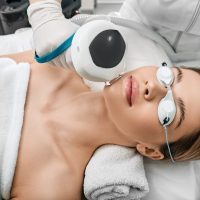What is Vascular Laser?
Thank you for reading this post, don't forget to subscribe!A vascular laser is a medical device used for the removal of face and leg veins. Spider veins, medically known as telangiectasias, are small veins that appear dilated and unattractive, often caused by various factors such as weak vascular walls, inefficient circulation, rosacea, sun exposure, hormonal changes, pregnancy, heredity, weight gain, leg injury, or occupations that require prolonged standing.
Am I a Good Candidate?
Here are some key points to consider when determining whether you are a good candidate for vascular laser treatment:
- You have spider veins or small varicose veins on your face or legs that you want to address.
- You are generally healthy and do not have any medical conditions that would contraindicate the procedure.
- Your skin type and tone will be considered to ensure that the appropriate type of laser is used for your treatment.
- You have realistic expectations about the outcome of the treatment, understanding that multiple sessions may be required for optimal results.
- You are committed to following post-treatment care instructions provided by your healthcare provider.
Benefits:
Here are some key benefits of vascular laser treatment for the removal of face and leg veins:
- Vascular laser treatment is a non-invasive procedure, meaning it does not require surgical incisions or downtime.
- Laser therapy selectively targets the red blood cells within the veins, leading to their disappearance while minimizing damage to surrounding tissues.
- Vascular laser treatment is effective in reducing the appearance of spider veins and small varicose veins on the face and legs.
- Patients typically experience minimal discomfort during the procedure, with some reporting only mild sensations of heat or tingling.
- There is usually little to no downtime associated with vascular laser treatment, allowing patients to resume their normal activities shortly after the procedure.
- When performed by a qualified healthcare provider, vascular laser treatment is considered safe with minimal risk of complications.
- Treatment parameters can be adjusted to accommodate individual skin types and vein characteristics, ensuring personalized and effective results.
- While multiple sessions may be required for optimal results, the effects of vascular laser treatment can be long-lasting, providing sustained improvement in vein appearance.
- Vascular laser treatment can be used to target veins on both the face and legs, offering a versatile solution for various vein issues.
More Details:
Removal of Face and Leg Veins
Spider veins, or telangiectasias, are tiny veins that constantly look dilated and unappealing. While leg veins may be caused by weak vascular walls and inefficient circulation, facial capillaries are often associated with rosacea, excessive sun exposure and exposure to heat. Heredity, pregnancy, hormonal changes, weight gain or leg injury may influence the occurrence of leg spider veins. Also, occupations that require standing are more at risk. Patients with leg varicosities complain of the unsightly appearance of the veins, and often report heaviness and swelling of the legs and feet.
Sclerotherapy is a treatment for the removal of spider and smaller varicose veins on the legs. Veins are injected with a sterile chemical, which irritates the vessel’s lining, causing it to become inflamed, harden, and eventually fade away completely. The injection needle is very small, and patients often feel little pain and do not need any anesthesia.
We prefer Laser treatment for leg or facial capillaries that are too small to be injected with sclerotherapy. Lasers provide a way to treat vessels safely, easily and effectively by selectively targeting the red blood cells which in turn heat and damage the vessels, leading to their disappearance. Patients can resume their normal daily activities after the procedure.
